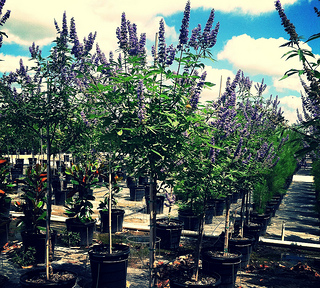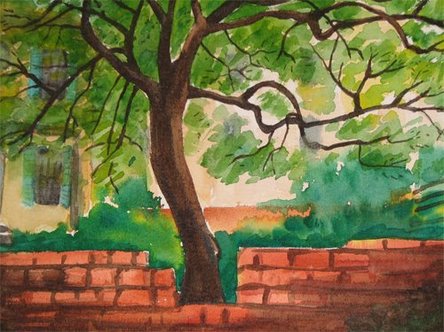
tel: 512-280-1192 Friday, June 14 2013
Nursery notes: for Dads who like to garden, our nursery is the
perfect place to find a gift before Sunday. We have mushroom-grow-
ing kits for $12.50 (reg. price $24.99); raised beds for $60 (4' x 4'
cedar); forest faces for $17.99, and gift certificates. Metal art on
sale - 20% off . / Stop by to pick up the latest wondrous issue of Edible
Austin; the focus is on summer beverages... but as usual there
are tons of fascinating features on the area's creative farmers, gard-
eners & chefs. (free)

We have beautiful Vitex (Montrose purple) currently in stock: 15 gal,
standard, 6 ft. tall for $129.99. This deciduous shrub thrives in full
sun, and prefers well-drained soil. Vitex has been used by herbalists
as a hormonal tonic for women for thousands of years. (Local herbalist
Ellen Zimmerman of EZ Herbs is a big fan.)
________________________________________________________
From the You Grow Girl blog comes this simple culinary adventure:
Soft Eggs on a Bed of Vegetables. All you need, writes Gayla Trail,
is a potato, scallions (or Egyptian walking onions if you've got 'em),
asparagus, radishes, and a couple of eggs. you grow girl
_______________________________________________________
Central Texas Gardener KLRU TV. Tempting outdoor projects for
kids over the summer months are suggested by Meredith O'Reilly,
including some ingenious milk-jug birdfeeders. On tour, a wildlife
haven designed by Bridget Lane: Sat. noon, 4 p.m. or Sun. at 9 a.m
www.klru /
_______________________________________________________
Help Save Bastrop, one seedling at a time. The Wildflower Center
and Treefolks plan to grow 900,000 Loblolly pines to reforest this
amazing park. Volunteer at the Wildflower Center Tuesday - Friday
8:30 a.m. – 12:30 p.m. and Saturday and Sunday 9:00 a.m. – 1:00 p.m.
No special skills required. Just show up and the nursery staff will
show you what to do. More info: loblolly

Neem:Texas's New Miracle Tree?
by Mick Vann
Back in the early to mid 70’s, when I was an avid vegetable gardener-
chef, I heard about a tree called the Neem tree, which sounded like a
miracle plant to me. A little background research was revealing: it
was native to India and Pakistan, was very drought resistant, and use-
ful in myriad ways.
Its root system was great for anchoring loose soils (the UN had a pro-
gram in the Sahara using neem trees to reclaim desert sands), the
leaves increased soil fertility, while the seed cake was great as a cattle
and poultry feed.
The twigs are used by millions as a natural toothbrush, and because of
high oil content, the fast-growing wood resists termites and rot, and is
used for all kinds of construction, including houses, fence posts, boats,
piers, docks, etc. Book repositories made of neem wood preserve paper
for millennia.
The oil makes an effective industrial lubricant and lamp oil. Bitter
tender leaf shoots are eaten all over SE Asia and the Subcontinent (excel-
lent in Thailand with chilled raw oysters and green chile sauce, or with
fried fish and sweet sauce).
We all know about its effectiveness as an insecticide, working system-
We all know about its effectiveness as an insecticide, working system-
ically as well as on a contact basis. It’s one of the few products that dis-
courages feeding on a crop (many pesticides have to be consumed
before they are effective). It works as an enstar inhibitor, and as a dig-
estive tract blocker, and has been tested as efficacious on over 200
different insects. (Most nurseries stock neem oil for use in the garden.)
Due to its antifungal, antibacterial, and antiviral properties neem oil
has been used in Ayurvedic holistic medicine for thousands of years.
(Ayurvedic medicine is a system of traditional alternative medicine
used in the Indian subcontinent.)
Neem kills internal parasites in humans and animals, and is a very
effective spermicide. It’s also used for the treatment of ulcers, burns,
leprosy, and skin lesions, and for internal ulcers and digestive prob-
lems in the stomach.
It is used to beautify hair, skin, and nails. Villages planted them to
reduce mosquitoes and ants in the area. The list is almost endless, so
much so that it is called “the village pharmacy” in India and “the
miracle tree” in Muslim countries, and it does all of this while being
completely non-toxic to humans.
New research indicates it is effective as an immune-booster, a liver-
protector, a possible diabetes treatment, and a rich source of anti-
oxidants when used as a dietary supplement. It is being tested in anti-
aging compounds and treatments for dry, itchy skin. Western resear-
chers are just starting to scratch the surface to discover what the Sub-
continent has known for thousands of years.
Jim Hightower, the Texas Agriculture Commissioner before Rick Perry
Jim Hightower, the Texas Agriculture Commissioner before Rick Perry
succeeded him and took credit for all of Jim’s progressive programs,
was a regular at the restaurant where I was a chef. I talked neem up to
Jim when he came in, and Jim got me some seeds from the USDA
Research Station down in Florida, where they were conducting trials.
My theory was that if Chinaberry (Melia azaderach) was a first cousin
of Neem (Azidirachta indica), and Chinaberry grows like a weed here,
there were two things to consider.
1. Does Chinaberry contain enough azadirachtin in its seeds to be use-
ful? (dunno; I’ve never been able to get any eggheads interested in
finding out) or, 2. Would Neem prosper down in the Valley, ensuring
a local Texas source for oil extraction? (turns out that it doesn’t appre-
ciate temperatures much below 36°F).
The neem tree is nothing short of a miracle plant, providing so many
The neem tree is nothing short of a miracle plant, providing so many
benefits they are almost too numerous to list (and I’ve only scratched
the surface in extolling its virtues). I would so love to be able to grow
neem trees here, but I think it gets too cold in the winter. Still, if you
were really dedicated, you could probably pull it off. And maybe after
we globally-warm a little more, the neem will become an adapted
plant. Texas’s new miracle tree!
(For organic pest control, the nursery stocks neem oil concentrate for
$17.99, and a ready-to-use combo of neem and pyrethrins for $15.99.)
Mick Vann is a horticulturist, food writer and blogger, chef, restaurant
consultant. Read Mick’s blog at http://gustidude.blogspot.com/ - his
latest, a brilliantly-written review of Luling's City Market.
 Visit the website: www.itsaboutthyme.com
Visit the website: www.itsaboutthyme.com Visit the nursery:11726 Manchaca Road, Austin, 78748